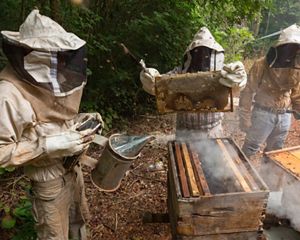Description
After the Amazon, Mesoamerica’s Maya Forest is the largest remaining tropical rainforest in the Americas. The 13.3-million-acre forest stretches across Belize, northern Guatemala and through Mexico’s Yucatan Peninsula. Its extensive and diverse forests provide refuge for countless rare and endangered species like the white lipped peccary, tapir, scarlet macaw, harpy eagle and howler monkey. One can often spot jaguar tracks on the forest’s floor. It is one of the few places on Earth where five large cat species live — jaguar, puma, ocelot, jaguarondi and margay. The Maya Forest harbors up to 400 species of birds, and in peak winter migratory months as many as several million birds rest in the area.
The forest also preserves archaeological sites of the ancient Maya civilization and today its descendants continue to live in this diverse landscape. The forest still plays a crucial role in maintaining and growing the local economy. Agriculture, harvesting timber, honey production and the harvest of other commercially important species such as allspice, chicle (traditional base for chewing gum), and xate palm (used in many floral arrangements) are staple livelihoods.
Mexican Forests
Mexico’s unique “ejido” system ensures that 70% of forests are community-owned and managed. Most of the indigenous groups in Mexico are focused on traditional economic activities that are forest-friendly and have not changed substantially from practices they have successfully employed in the area for thousands of years.
For example throughout the Yucatan Peninsula, many ejidos continue to focus on subsistence farming, utilizing a “milpa” system which combines corn, beans, and other crops and is compatible with forest conservation. Bee-keeping, which is compatible with the milpa system and with the forests is also practiced throughout the Peninsula. Finally, forest management is another important source of income for many ejidos.
This system is facing increasing pressures from commercial agriculture, outdated subsidies, road construction, mining, and tourist development. This contributes to over 370,658 acres of deforestation and up to 741,316 acres of forest degradation annually. Clearing forests is still seen as the main path to economic well-being and this dynamic has made the Yucatan Peninsula one of the main deforestation hot spots in the country. Rather than offering a solution, this destruction deepens the cycle of poverty by threatening food security, reducing access to clean water, and increasing vulnerability to climate change.
* An ejido is a self-governing land cooperative unique to Mexico.
After working for several years on the establishment and management of a strong and effective system of protected areas in the Maya Forest, the Conservancy has developed new strategies to reduce deforestation in the unprotected corridors. In order to counteract the increasing threats TNC is promoting responsible forest management practices that are compatible with economic development. The Conservancy is committed to conservation that fosters a healthy forest ecosystem and the continued existence of the Maya culture.
A Unique Opportunity
Building on its experience in restoring and protecting the Maya Forest, The Nature Conservancy is leading a consortium to design and implement programs to reduce emissions from deforestation and forest degradation and promote reforestation (REDD+). Working with its partners in the Yucatan Peninsula and other places around the country, TNC is promoting local economic opportunities that are compatible with forest conservation. This work focuses on several related strategies:
- Strengthening community institutions. We are working with communities to develop property-wide management plans, providing training on business and financial management, and facilitating access to technical assistance.
- Implementing best practices. The Conservancy is working with local organizations to implement models of improved ranching, sustainable agriculture, improved forest management, and other forest-friendly practices. We are helping communities find ways to add value to their productive activities, for example, by helping install local sawmills and carpentry shops.
- Reforestation. we are working with local partners to restore and reforest degraded lands in critical areas like biological corridors and watersheds using high-value native species.
- Improving policies. In addition to working directly with communities, TNC is helping strengthen and improve polices. For example, TNC is demonstrating how to improve Mexico’s widespread payments-for-environmental-services program by coupling those payments with technical assistance to manage and invest the resources in sustainable production.
Mexican forests need empowered communities that are successful in protecting their heritage, their home, and their livelihoods.





